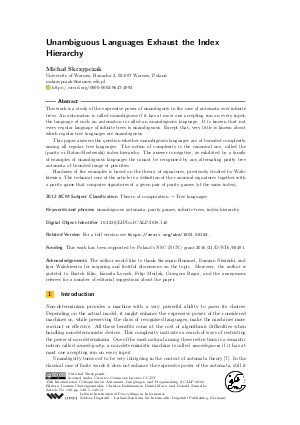Unambiguous Languages Exhaust the Index Hierarchy
Author
Michal Skrzypczak 
-
Part of:
Volume:
45th International Colloquium on Automata, Languages, and Programming (ICALP 2018)
Part of: Series: Leibniz International Proceedings in Informatics (LIPIcs)
Part of: Conference: International Colloquium on Automata, Languages, and Programming (ICALP) - License:
 Creative Commons Attribution 3.0 Unported license
Creative Commons Attribution 3.0 Unported license
- Publication Date: 2018-07-04
File

PDF
LIPIcs.ICALP.2018.140.pdf
- Filesize: 0.5 MB
- 14 pages
Document Identifiers
Related Versions
Subject Classification
ACM Subject Classification
- Theory of computation → Tree languages
Keywords
- unambiguous automata
- parity games
- infinite trees
- index hierarchy
Metrics
- Access Statistics
-
Total Accesses (updated on a weekly basis)
0Document
0Metadata
Abstract
This work is a study of the expressive power of unambiguity in the case of automata over infinite trees. An automaton is called unambiguous if it has at most one accepting run on every input, the language of such an automaton is called an unambiguous language. It is known that not every regular language of infinite trees is unambiguous. Except that, very little is known about which regular tree languages are unambiguous. This paper answers the question whether unambiguous languages are of bounded complexity among all regular tree languages. The notion of complexity is the canonical one, called the (parity or Rabin/Mostowski) index hierarchy. The answer is negative, as exhibited by a family of examples of unambiguous languages the cannot be recognised by any alternating parity tree automata of bounded range of priorities. Hardness of the examples is based on the theory of signatures, previously studied by Walukiewicz. The technical core of the article is a definition of the canonical signatures together with a parity game that compares signatures of a given pair of parity games (of the same index).
Cite As Get BibTex
Michal Skrzypczak. Unambiguous Languages Exhaust the Index Hierarchy. In 45th International Colloquium on Automata, Languages, and Programming (ICALP 2018). Leibniz International Proceedings in Informatics (LIPIcs), Volume 107, pp. 140:1-140:14, Schloss Dagstuhl – Leibniz-Zentrum für Informatik (2018)
https://doi.org/10.4230/LIPIcs.ICALP.2018.140
BibTex
@InProceedings{skrzypczak:LIPIcs.ICALP.2018.140,
author = {Skrzypczak, Michal},
title = {{Unambiguous Languages Exhaust the Index Hierarchy}},
booktitle = {45th International Colloquium on Automata, Languages, and Programming (ICALP 2018)},
pages = {140:1--140:14},
series = {Leibniz International Proceedings in Informatics (LIPIcs)},
ISBN = {978-3-95977-076-7},
ISSN = {1868-8969},
year = {2018},
volume = {107},
editor = {Chatzigiannakis, Ioannis and Kaklamanis, Christos and Marx, D\'{a}niel and Sannella, Donald},
publisher = {Schloss Dagstuhl -- Leibniz-Zentrum f{\"u}r Informatik},
address = {Dagstuhl, Germany},
URL = {https://drops.dagstuhl.de/entities/document/10.4230/LIPIcs.ICALP.2018.140},
URN = {urn:nbn:de:0030-drops-91442},
doi = {10.4230/LIPIcs.ICALP.2018.140},
annote = {Keywords: unambiguous automata, parity games, infinite trees, index hierarchy}
}
Author Details
Funding
This work has been supported by Poland’s NSC (NCN) grant 2016/21/D/ST6/00491.
References
-
André Arnold. The mu-calculus alternation-depth hierarchy is strict on binary trees. ITA, 33(4/5):329-340, 1999.

-
André Arnold and Damian Niwiński. Continuous separation of game languages. Fundamenta Informaticae, 81(1-3):19-28, 2007.

-
Marcin Bilkowski and Michał Skrzypczak. Unambiguity and uniformization problems on infinite trees. In CSL, pages 81-100, 2013.

-
Julian C. Bradfield. Simplifying the modal mu-calculus alternation hierarchy. In STACS, pages 39-49, 1998.

-
Arnaud Carayol and Christof Löding. MSO on the infinite binary tree: Choice and order. In CSL, pages 161-176, 2007.

-
Arnaud Carayol, Christof Löding, Damian Niwiński, and Igor Walukiewicz. Choice functions and well-orderings over the infinite binary tree. Cent. Europ. J. of Math., 8:662-682, 2010.

-
Thomas Colcombet. Forms of determinism for automata. In STACS, pages 1-23, 2012.

-
Jacques Duparc, Kevin Fournier, and Szczepan Hummel. On unambiguous regular tree languages of index (0, 2). In CSL, pages 534-548, 2015.

-
Allen Emerson and Charanjit Jutla. Tree automata, mu-calculus and determinacy. In FOCS'91, pages 368-377, 1991.

-
Yuri Gurevich and Saharon Shelah. Rabin’s uniformization problem. J. Symb. Log., 48(4):1105-1119, 1983.

-
Szczepan Hummel. Unambiguous tree languages are topologically harder than deterministic ones. In GandALF, pages 247-260, 2012.

-
Szczepan Hummel. Topological Complexity of Sets Defined by Automata and Formulas. PhD thesis, University of Warsaw, 2017.

-
Alexander S. Kechris. Classical descriptive set theory. Springer-Verlag, New York, 1995.

-
Andrzej W. Mostowski. Games with forbidden positions. Technical report, University of Gdańsk, 1991.

-
Damian Niwiński and Igor Walukiewicz. Ambiguity problem for automata on infinite trees. unpublished, 1996.

-
Richard E. Stearns and Harry B. Hunt. On the equivalence and containment problems for unambiguous regular expressions, regular grammars and finite automata. SIAM Journal of Computing, 14(3):598-611, 1985.

-
Robert S. Streett and E. Allen Emerson. An automata theoretic decision procedure for the propositional mu-calculus. Information and Computation, 81(3):249-264, 1989.

-
Wolfgang Thomas. Languages, automata, and logic. In Handbook of Formal Languages, pages 389-455. Springer, 1996.

-
Wolfgang Thomas and Helmut Lescow. Logical specifications of infinite computations. In REX School/Symposium, pages 583-621, 1993.

-
Igor Walukiewicz. Pushdown processes: Games and model checking. In Rajeev Alur and Thomas A. Henzinger, editors, Computer Aided Verification, pages 62-74, Berlin, Heidelberg, 1996. Springer Berlin Heidelberg.

-
Igor Walukiewicz. Monadic second-order logic on tree-like structures. Theoretical Computer Science, 275(1-2):311-346, 2002.

